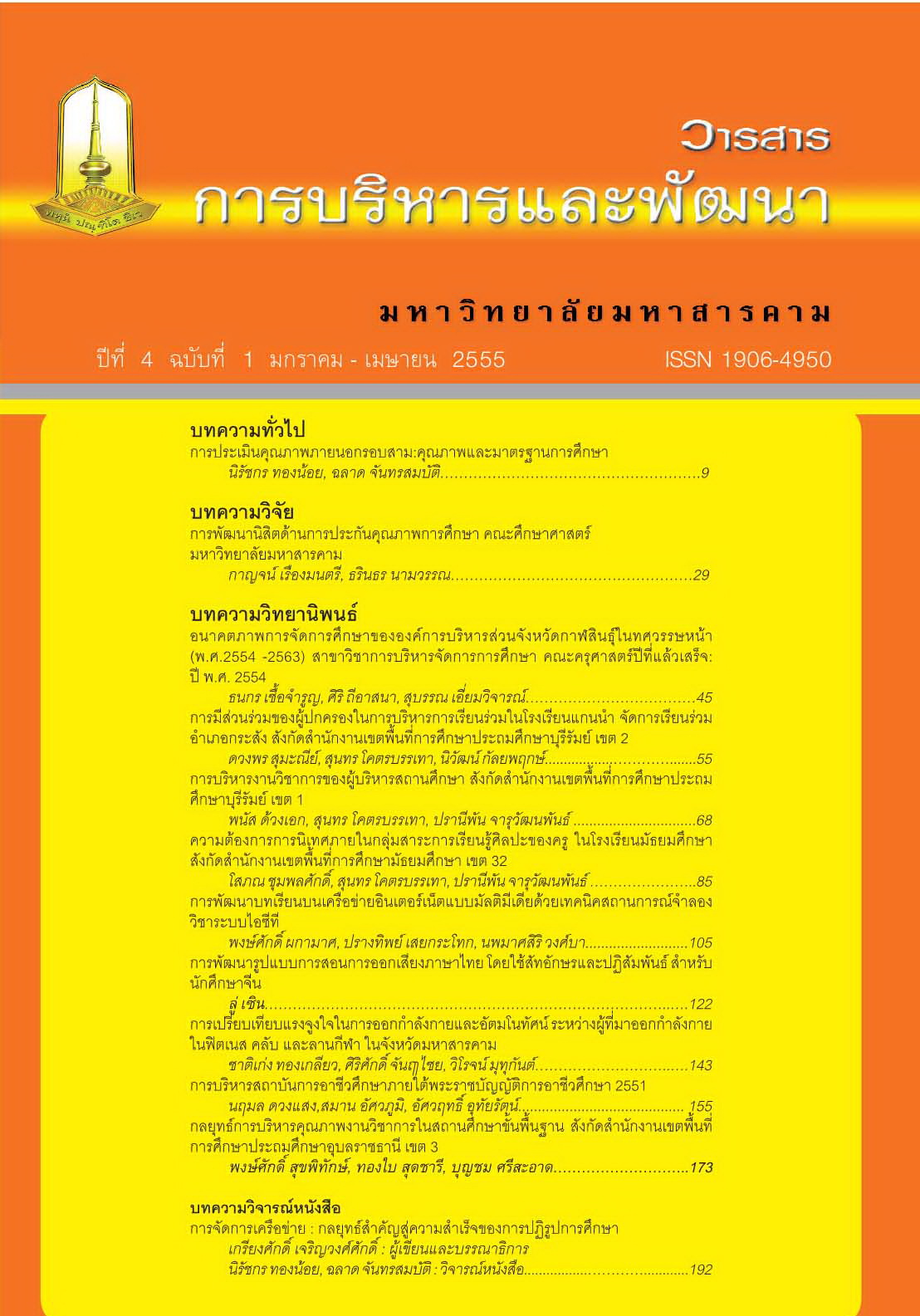การพัฒนารูปแบบการสอนการออกเสียงภาษาไทย โดยใช้สัทอักษร และปฏิสัมพันธ์ สำหรับนักศึกษาจีน
Main Article Content
Abstract
บทคัดย่อ
การวิจัยครั้งนี้มีจุดมุ่งหมาย คือ 1) เพื่อพัฒนารูปแบบการสอนการออกเสียงภาษา ไทย โดยใช้ สัทอักษรและปฏิสัมพันธ์สำหรับนักศึกษาจีน 2) เพื่อทดสอบประสิทธิภาพของ รูปแบบการสอนการอ่านออกเสียงภาษาไทย โดยใช้สัทอักษรและปฏิสัมพันธ์สำหรับนักศึกษา จีนให้มีประสิทธิภาพตามเกณฑ์ E1/E2 = 80/80 และ 3) เพื่อรับรองรูปแบบการสอนการ ออกเสียงภาษาไทย โดยใช้สัทอักษรและปฏิสัมพันธ์สำหรับนักศึกษาจีน วิธีดำเนินการวิจัย ประกอบด้วย 1) ศึกษาเอกสารและงานวิจัยที่เกี่ยวข้องและสัมภาษณ์เชิงลึก 2) พัฒนาร่าง รูปแบบการสอน 3) ตรวจสอบคุณภาพของแบบรูปแบบ 4) ทดสอบประสิทธิภาพของรูปแบบ 5) ประเมินเพื่อรับรองรูปแบบการสอนโดยผู้ทรงคุณวุฒิ กลุ่มตัวอย่างที่ใช้ในการวิจัย แบ่ง เป็นกลุ่มตัวอย่างที่ใช้สัมภาษณ์เชิงลึก ได้แก่ ผู้ทรงคุณวุฒิด้าน การสอนภาษาไทย หัวหน้าภาควิชาภาษาไทย อาจารย์ผู้สอนภาษาไทย และนักศึกษาที่เคยเรียนภาษาไทย ในสถาบัน อุดมศึกษาในประเทศจีน จำนวน 45 คน กลุ่มตัวอย่างที่ใช้ในการทดสอบประสิทธิภาพ รูปแบบการสอนการออกเสียงภาษาไทยโดยใช้สัทอักษรและปฏิสัมพันธ์ ได้แก่ นักศึกษาจีน มหาวิทยาลัยชนชาติ ยูนนานที่ลงทะเบียนเรียนภาษาไทย ภาคเรียนที่ 1 ปีการศึกษา 2552 จำนวน 35 คน และกลุ่มตัวอย่างที่ใช้ ตรวจสอบคุณภาพของรูปแบบโดยการสนทนากลุ่ม (focus group) ได้แก่ ผู้เชี่ยวชาญด้านเทคโนโลยีการศึกษาและผู้เชี่ยวชาญด้านการสอน ภาษาไทยให้แก่ชาวต่างชาติ จำนวน 17 คน เครื่องมือที่ใช้ในการวิจัย ได้แก่ 1) รูปแบบการสอนการออกเสียงภาษาไทยโดยใช้สัทอักษรและปฏิสัมพันธ์ สำหรับนักศึกษาจีน 2) แผนการ สอนตามรูปแบบการสอนการออกเสียงภาษาไทยโดยใช้ สัทอักษรและปฏิสัมพันธ์ สำหรับ นักศึกษาจีน 3) แบบทดสอบหลังเรียน 4) แบบประเมินรับรองรูปแบบ การสอนการออกเสียง ภาษาไทยโดยใช้สัทอักษรและปฏิสัมพันธ์ สำหรับนักศึกษาจีนโดยผู้ทรงคุณวุฒิ
ผลการวิจัยพบว่า
1. รูปแบบการสอนการออกเสียงภาษาไทยโดยใช้สัทอักษรและปฏิสัมพันธ์ สำหรับ นักศึกษาจีน ประกอบด้วย 5 ขั้นตอน ได้แก่ 1) ทบทวนความรู้เดิม 2) นำเสนอความรู้ใหม่ โดยใช้สัทอักษร 3) กิจกรรมปฏิสัมพันธ์ 4) ทดสอบหลังเรียน และ 5) ประเมินและปรับปรุง 2. ประสิทธิภาพของรูปแบบการสอนการออกเสียงภาษาไทยโดยใช้สัทอักษรและ ปฏิสัมพันธ์ สำหรับนักศึกษาจีน มีประสิทธิภาพ E1/E2 เท่ากับ 81.51/82.51 เป็นไปตามเกณฑ์ มาตรฐานที่กำหนด
3. ผลการประเมินรับรองรูปแบบการสอนการออกเสียงภาษาไทยโดยใช้สัทอักษร และปฏิสัมพันธ์ สำหรับนักศึกษาจีน จาก ผู้ทรงคุณวุฒิอยู่ในระดับ “เหมาะสมมากที่สุด”
คำสำคัญ : การพัฒนารูปแบบการสอนการออกเสียงภาษาไทย, สัทอักษรและปฏิสัมพันธ์
Abstract
The purposes of this research were: 1) to develop an instructional model of Thai language pronunciation using phonetic alphabet and personal interaction for Chinese students, 2) to test the efficiency of the instructional model of Thai language pronunciation using phonetic alphabet and personal interaction for Chinese students with the standard criteria for efficiency of E1/E2 = 80/80 and 3) to validate the instructional model of Thai language pronunciation using phonetic alphabet and personal interaction for Chinese students.
The sample were groups of experts in Thai language such as head of the Thai language department, instructors, and 45 students who used to study Thai language at higher education institutions in Yunnan province. 35 students at Yunnan Nationationalities University who enrolled in the 1/2552 academic year tested the efficiency of the model of Thai language pronunciation using phonetic alphabet and personal interaction for Chinese students. The samples in a focus group were experts in educational technology and experts in teaching Thai to foreigners.
The instruments used in this research were 1) instructional model of Thai language pronunciation using phonetic alphabet and personal interaction for Chinese students, 2) lesson plan according to the instructional model of Thai language pronunciation using phonetic alphabet and personal interaction for Chinese students, 3) post-test, 4) evaluation form to validate the effectiveness of Thai language pronunciation instructional model using phonetic alphabet and personal interaction for Chinese students by experts.
The research results reveal that:
1. Thai language pronunciation Instructional model using phonetic alphabet and personal interaction for Chinese students consisted of 5 steps: 1) review of background knowledge, 2) presentation of the new knowledge by using phonetics, 3) interaction activities, 4) post-test, 5) evaluation and improvement.
2. The result of the efficiency test of the instructional model of Thai language pronunciation using phonetic alphabet and personal interaction for Chinese students found the efficiency criteria of E1/E2= 81.51/82.51 which neet the set standard criteria.
3. The result from the evaluation validated the instructional model of Thai language pronunciation using phonetic alphabet and personal interaction for Chinese students. Experts from both the Thai language field and educational technology field agree that the model is highly appropriate.
Keywords : A Development of Thai Language Pronouncing Instructional Model, Using Phonetic Alphabet and Personal Interaction

